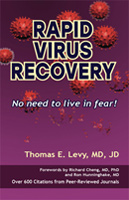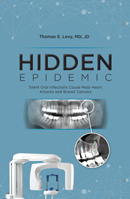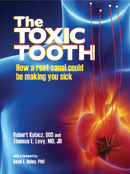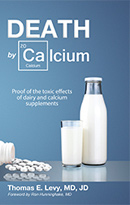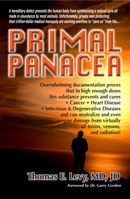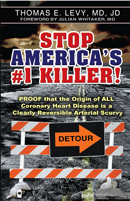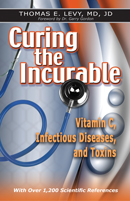The Clinical Impact of Vitamin C: My Personal Experiences as a Physician
09/03/2014 by Dr. Thomas Levy(OMNS Sept 3, 2014) My ongoing relationship with vitamin C now spans a full 20 years, when I first met Dr. Hal Huggins, a pioneering dentist who opened my eyes to a wide array of clinical approaches to different diseases with hitherto unheard-of clinical results at his clinic in Colorado Springs. I can honestly say that my first visit to his clinic began the most meaningful part of my medical education. Nothing has been the same since. My office where I practiced adult cardiology ended up being shuttered shortly after that first visit. And I have never looked back.
While there are many things I learned from Dr. Huggins, and there were many areas I then ended up exploring because of what he taught me, the single most important thing I learned from him was the incredible ability of vitamin C to improve or heal so many conditions. Without exception, seriously ill patients, often with such diseases as Parkinson's, ALS, Alzheimer's, MS, and atherosclerosis, almost always had extensive dental toxicity in the form of root canal-treated teeth, infected dental implants, mercury amalgams, extensive cavitational osteonecrosis, and/or advanced periodontal disease. Each of these individuals had anywhere from three to five sessions of extensive dental work, typically involving a great deal of dental surgery along with the inevitable exposure to the toxins associated with anaerobic dental infections and the inescapable assimilation of some mercury vapor if amalgams were being removed. However, all of these patients received 50-gram (50,000 mg) infusions of vitamin C administered continuously before, during, and following the dental sessions. In patients with diseases that I had been led to believe could not really be improved upon, dramatic clinical improvement was routinely apparent immediately following the dental sessions.
While I knew the removal of dental toxicity was very important in their clinical improvements, watching these patients perk up after their first vitamin C infusion was extraordinary. Most healthy people I knew just wanted to go to bed after hours of extensive dental work. On at least one memorable occasion, after the first vitamin C infusion was complete, one especially sickly patient immediately began talking with her caregiver about what restaurant they could go to that evening to enjoy a meal. This patient had several teeth extracted, but was still looking forward to attacking a steak with the remaining teeth in her mouth. On a few priceless occasions, I even saw some wheelchair-bound patients take a few steps, with assistance, before they finished their two-week treatment period at the clinic.
Seeing was believing, and I realized the entire way that I approached patient care simply had to change. I needed learn a lot more about the intravenous delivery of this molecule known as ascorbic acid, or ascorbate. I resolved to research this vitamin as completely as possible, learn the nuances of that research as best I could, and then proceed to spread the word on the application of this incredibly potent, inexpensive, and non-toxic substance.
Research
Many of the "leads" that I followed in accumulating the many thousands of abstracts and articles came from the 1972 ground-breaking book by Irwin Stone entitled, The Healing Factor: "Vitamin C" Against Disease. Stone obtained forewords for his book by the renowned Nobel Prize winners, Albert Szent-Gyorgyi, who had discovered vitamin C in 1932, and Linus Pauling, who pretty much put vitamin C into the public eye as nobody else has been able to do.
In order not to miss any significant information published in the medical literature about vitamin C since the publication of Stone's book, I entered the term "ascorbic acid" into the search engine of PubMed, and list of about 24,000 articles appeared. I gave all of these articles careful consideration in documenting the many clinical effects and laboratory effects of vitamin C. What began to emerge as I proceeded to review these thousands of articles was that vitamin C is more important than any other treatment for infection or exposure to toxin. Probably most impressive was the fact that vitamin C in test tube experiments had always neutralized any toxin to which it was exposed, regardless of the chemical structure of the toxin.
The validation and enormous importance of much of this test tube research came from the work of Frederick Klenner, MD in North Carolina. His clinical experience demonstrated how vitamin C was just as effective in the body as in the test tube in neutralizing or negating the toxic impact of whatever toxin the patient was exposed to. Snake venom, heavy metals, pesticides, cyanide, alcohol, carbon monoxide were all neutralized. The results that Dr. Klenner reported with infections were also astounding, as vitamin C, properly administered, proved to be the ultimate virucidal agent, curing all acute viral infections. These viral infections remain incurable by the standard approaches of modern medicine today. Furthermore, Klenner showed that vitamin C was also very effective in the treatment of many non-viral infections, improving the efficacy of treatment by antibiotics and other medications administered today. While I have seen but a fraction of the types of conditions that Dr. Klenner described, I fully believe the accuracy of everything Dr. Klenner published. I have applied vitamin C treatment to many patients with conditions similar to those treated by Dr. Klenner, along with several other conditions that Dr. Klenner did not have the opportunity to treat. With the perspective of this clinical experience, I have little reason to doubt any of the fabulous outcomes that he reported.
What I Have Witnessed
I recall here some of the most dramatic anecdotes about the healing power of vitamin C in the hope of conveying to the reader what an extraordinary addition it can be to the clinical options of any medical doctor. Shortly after the vitamin C book was completed and published, I began a limited clinical practice with a few colleagues. The circumstances were pretty much ideal for me, as I was able to give or prescribe intravenous vitamin C as needed.
Severe Influenza
In 2003 Denver was in the middle of a flu epidemic that infected over 6,000 individuals and ended up killing more than ten children and infants. In this setting, a slender but healthy 26-year-old woman developed a persistent fatigue that continued to progress. After a month of this ongoing fatigue she fell severely ill very quickly, with the classical flu-like symptoms of fever, chills, muscle aches and pains, headaches, and nausea. She tried in vain to deal with her symptoms and still go to school. However, after about a week of these symptoms and trying to maintain a normal level of activity, she only had the energy to stay in bed.
She remained in bed for the next ten weeks. Even her short trips to the bathroom depleted what little energy she had, as the out-of-bed excursions would cause her to feel feverish and would worsen her headaches. When I first saw her, she had lost 20% of her body weight, going from 100 pounds down to about 80 pounds. In response to a plea from her caregiver, I made a house call to her with my office manager/assistant, and we administered her first vitamin C IV there. I found her primarily just emaciated and appearing very malnourished. There was no evidence of liver enlargement or enlarged lymph nodes. Her bloodwork suggested a past Epstein-Barr virus infection, and it was reasoned that this chronic viral infection had just made her all the more susceptible to the epidemic of flu that was working its way through Denver and the rest of Colorado.
Her first IV consisted primarily of 50 grams of vitamin C as sodium ascorbate in 1,000 cc of lactated Ringer's solution infused slowly over a period of about three hours. Six grams of glutathione was added toward the end of the infusion. The next five infusions contained 100 grams of sodium ascorbate, completed by the six grams of glutathione.
The morning after the first IV she was free of headaches for the first time in three months, and she felt much stronger. However, by the second infusion, she was able to walk a bit around the house. By the morning after the third infusion, she was able to walk outside and enjoy a little sunshine. She was able to walk into the clinic for her fourth infusion and subsequent treatments. She felt completely normal the day after the fourth infusion, but two more infusions over two more days were administered to prevent the possibility of relapse. An oral regimen of supplementation was started, and she was discharged from regular care.
Of particular importance in understanding the amount of vitamin C needed to effectively cure this patient's chronic/acute viral syndrome is to note the patient's weight of 80 pounds when first seen. 100 grams of vitamin C in a 80-pound patient is equivalent to 250 grams in a 200-pound patient. Further, the efficacy of the vitamin C was enhanced by the glutathione administration. Our conclusion from many similar cases was that any viral syndrome not resolving with vitamin C was almost always due to inadequate total dose, along with the virus not being readily accessible by the molecules of vitamin C, as in chronic hepatitis. A terminal (not early stage) case of a dangerous virus such as Ebola in a nutrient-depleted body might require even higher doses of vitamin C for clinical resolution, depending upon body size.
H1N1 Influenza
A New Zealand farmer contracted H1N1 influenza in 2009. Well-documented on New Zealand's version of 60 Minutes, this individual had progressed to the point of being on life support, and the doctors had nothing further to offer.
https://www.youtube.com/watch?v=VrhkoFcOMII or
https://www.youtube.com/watch?v=vTXSTGGRvKY
A family member contacted me to ask what to do, and I advised intravenous vitamin C, 50 grams or more daily, immediately. However, I did not think there was any chance that the hospital or doctors would allow such treatment.
After an enormous struggle, the family finally got the doctor in charge to give vitamin C before "pulling the plug." 25 grams of vitamin C was given intravenously the first day, 50 grams the second day, 75 grams the third day, and then 100 grams daily for 4 to 5 more days. At that point a new doctor in charge of the case discontinued the vitamin C completely, for unclear reasons, even though the patient was clearly responding, waking up, and dramatically clearing up the previous "white-out" state seen in chest X-rays of his congested lungs. A full week later, intravenous vitamin C was restarted at a mere one gram twice daily. But for the docs who thought the vitamin C was a foolish intervention, the proof of its efficacy was already at hand.
Pulmonary Embolism
While visiting Colombia, South America, I had the opportunity to see a 30-year-old woman who was bedridden and appearing to be in imminent danger of dying. She had been diagnosed with pulmonary embolism, and both of her legs were tender and swollen, appearing ready to set loose further emboli that would seal her fate. She was already on Coumadin anticoagulation, and her blood tests indicated the thinning of her blood was optimal.
Since I had brought some supplies with me on this trip in order to give a few selected friends (as well as myself) some intravenous vitamin C, I decided to try to help this individual out as best I could. While I was concerned about the vitamin C neutralizing the anticoagulant effects of the Coumadin, I was hoping to relieve her suffering a bit. I proceeded to give her 50 grams of vitamin C over about three hours. She tolerated the infusion well.
The following afternoon I returned to give her another vitamin C infusion. Her improvement was nearly miraculous. She was sitting up in bed and combing her hair, as she had just gotten out of bed and taken a shower on her own.
On the fourth day, following the third infusion, she was smiling and very pleased to report how good her legs were feeling. I was very pleased, but I was also concerned over the possibility of relapse, as I could not continue the IV infusions. She did continue to improve, however, as I left her with several months worth of vitamin C powder, taken at 2,000 mg daily.
West Nile Virus
I have treated two cases of West Nile virus, and both responded very dramatically. A Colorado man in his 60s had already been sick for a month or two when he went to his local hospital and ended up testing positive for West Nile virus. His symptoms included persistent headaches, a bit of disorientation, and a low-grade fever. Upon arrival at my clinic, he was given 75 grams of vitamin C intravenously followed by 6 grams of glutathione intravenously. He was also given a hyperbaric oxygen treatment. By 36 hours post-treatment, he felt completely normal and remained so.
Another man in his 50s contracted the West Nile virus and presented with a history of chronic virus-associated symptoms over the preceding six months. He received three infusions of vitamin C on consecutive days and reported having no further symptoms after the completion of the third infusion. There was no clinical relapse, and the cure was complete. He commented that the whole experience seemed "like a miracle."
Infectious Mononucleosis
Two college students presented with chronic infectious mononucleosis. Both had been sick for months, primarily with severe fatigue, and they had already dropped out of their classes, not having the energy to continue. Both received several 50-gram infusions of vitamin C and had prompt, complete resolution of their chronic infections and persistent symptoms.
Acute Lyme Disease
A young woman in Pennsylvania was bitten by a pathogen-carrying tick, developed the classical Lyme-associated rash, and proceeded to get very ill over the next seven to ten days. She received several infusions of vitamin C at her house. The first infusion was 100 grams, and her caregiver reported that she seemed much improved upon the completion of that infusion. Five more infusions of 50 grams each were given over the next two days. By the time that 72 hours had passed, she was completely well, never having a clinical relapse or any chronic Lyme symptoms.
Chronic Lyme Disease
A woman with a 12-year history of chronic Lyme disease, documented by blood testing, desired having regular and prolonged high-dose intravenous vitamin C therapy for her condition. Under the aegis of a prescribing physician who had attended one of my presentations of vitamin C, a nurse practitioner was able to give the patient what she wished.
This individual had already been taking liposome-encapsulated vitamin C and glutathione orally without a significant improvement in her condition. On four consecutive days, she received infusions of 25, 50, 75, and then 100 grams of vitamin C. Then, for 19 more days, she received 5 or 6 infusions weekly of 100 grams of vitamin C in each infusion. Until day 23, she felt no improvement. However, she was determined to continue in spite of the lack of improvement and the increasing expense of the whole process. On day 23, the nurse practitioner reported that she looked like a new person, and that it was like a "switch was flipped" and she was well. At her request, the patient received another week of 100 gram daily infusions to be sure her condition was truly resolved, a very good idea on her part. About a month later, her Lyme blood testing was completely negative.
A physician reported to me similar experiences with a series of Lyme patients, who showed no positive clinical response after an extended number of vitamin C infusions, then had a dramatic, abrupt clinical resolution of their condition, very much as described above.
Final Notes
Vitamin C is truly Nature's gift to health and healing. Virtually all medical conditions are associated with increased oxidative stress, and the relief, or at least partial relief, of this oxidative stress with the vigorous administration of vitamin C and other quality antioxidants, will always help. The oxidative stress caused by disease and environmental toxins can deplete the body's level of vitamin C and other antioxidants. In serious illness, the body's reserve of vitamin C goes to zero because the rate at which the body regenerates it is far lower than the rate of depletion. This can require huge doses to bring it back to normal. Even if you are taking antibiotics or other prescription medicines, bringing your levels of vitamin C in your body back to normal, or temporarily supranormal, will virtually always result in profound benefits.
The treatment is effective and, compared to the expense of conventional treatment, it is inexpensive. Few medicines and therapeutic interventions are more affordable than, and as non-toxic as, vitamin C. Even though something as extraordinarily beneficial as vitamin C might seem too good to be true, that's definitely not the case.
More Orthomolecular articles:
11/11/2010 | Vitamin C And The Law
02/14/2012 | Vitamin C Prevents Vaccination Side Effects; Increases Effectiveness
08/27/2013 | Vitamin C, Shingles, and Vaccination
09/03/2014 | The Clinical Impact of Vitamin C:
My Personal Experiences as a Physician
05/31/2019 | Curing Polio with Magnesium: The tip of the iceberg?
10/25/2019 | Reboot Your Gut: Optimizing Health and Preventing Infectious Disease
01/29/2020 | Vaccinations, Vitamin C, Politics, and the Law
07/18/2020 | COVID-19: How can I cure thee? Let me count the ways
08/21/2020 | Curing Viruses with Hydrogen Peroxide: Can a simple therapy stop the pandemic?
05/10/2021 | Hydrogen Peroxide Nebulization and COVID Resolution: Impressive Anecdotal Results
06/21/2021 | Resolving Long-Haul COVID and Vaccine Toxicity: Neutralizing the Spike Protein
10/18/2021 | Canceling the Spike Protein: Striking Visual Evidence
12/11/2021 | Vitamin C and Cortisol: Synergistic Infection and Toxin Defense
02/01/2022 | How COVID Helped Me Regain Good Health
05/11/2022 | The Restoration of Vitamin C Synthesis in Humans
06/01/2022 | Monkeypox Infection - To Fear or Not to Fear?
09/08/2022 | Atherosclerosis is a Non-Healing Wound
01/05/2023 | Myocarditis: Once Rare, Now Common
02/04/2023 | Resolving Colds to Advanced COVID with Methylene Blue
03/10/2023 | Resolving Persistent Spike Protein Syndrome
07/31/2023 | The Toxic Nutrient Triad
09/27/2023 | Persistent Spike Protein Syndrome: Rapid Resolution with Ultraviolet Blood Irradiation
10/12/2023 | Schizophrenia Is Chronic Encephalitis...and Niacin Cures It
11/03/2023 | Heart Failure or Therapy Failure? Toxins Cause Cardiomyopathy
12/17/2023 | Root Canals Cause Breast Cancer-Frequently
Article also available at Orthomolecular Medicine News Service
OMNS free subscription link http://orthomolecular.org/subscribe.html
OMNS archive link http://orthomolecular.org/resources/omns/index.shtml


